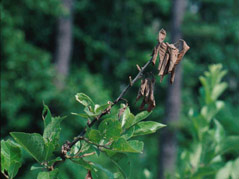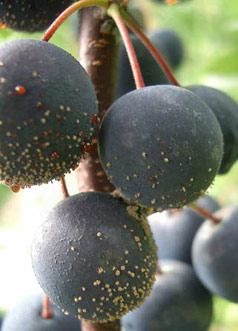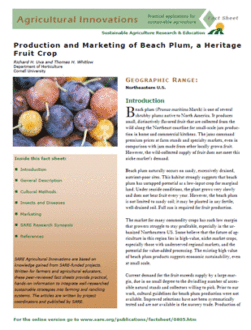Even though beach plum is a native crop, it is subject to a number of insect and disease problems typically found on other cultivated plums—the most serious being brown rot, plum curculio, and plum gouger. Consult guides on plum or stone fruit pests to find more information on these problems and treat them as you would other plums; also, consult the beach plum management schedule (Table 2).


| Table 2. Beach Plum Management Schedule Developed by David Simser, Cape Cod Cooperative Extension and Richard Uva, Cornell University | |
| February | PRUNING and training as needed. |
| Late-April (white bud) | Consider applying control measures for BROWN ROT (blossom blight phase). |
| Early-May | Apply FERTILIZER. As nitrogen is mobile, especially in sandy soil, consider applying 1/2 of nitrogen on now and the other 1/2 on in late May or June. |
| Mid-May (Bloom) | Were pollinators present and active during BLOOM? Start to SCOUT FOR PESTS on a regular schedule. Prepare and activate the IRRIGATION system if using one. |
| Late-May (after bloom) | Consider applying control measures for BROWN ROT (blossom blight phase) and for PLUM CURCULIO/PLUM GOUGER. |
| June | Control small WEEDS now instead of big weeds in July. |
| Mid-June (shuck split) | Consider applying control measures for BROWN ROT and for PLUM CURCULIO/PLUM GOUGER. Fruit THINNING may be required to reduce excessive fruit loads and to reduce biennial bearing. |
| Late-June (green fruit) | Consider applying control measures for BROWN ROT and CATERPILLARS (if needed). |
| Early-August (1st color) | Consider Appling control measures for BROWN ROT (fruit rot phase) as fruit begin to turn from green to yellow in early August. Collect soil and foliage samples for nutrient analysis at this time if desired. |
| Mid-August (pre-ripe) | Consider applying control measures for BROWN ROT (fruit rot phase) if needed. |
| Late-August (ripe) | Begin fruit HARVEST. Because most farms are growing seedling plants (which are all genetically different) there is wide variation in ripening time from plant to plant. Consider protection from BIRDS. |
| September | Remove fallen fruit and premature leaf drop from orchard floor. |
| October | Drain and WINTERIZE the irrigation system. Remove fallen fruit and leaf drop from the orchard floor. Protect plants from browsing/girdling—DEER, VOLES, MICE, etc. |
| PESTICIDES--Pesticide recommendations are for informational purposes only, read the manufacturers' recommendations before use. We assume no responsibility for the use of any pesticide or chemicals. For detailed information on plum pest control consult your state extension service’s pest management guidelines for commercial tree-fruit and follow the directions for plum. |
